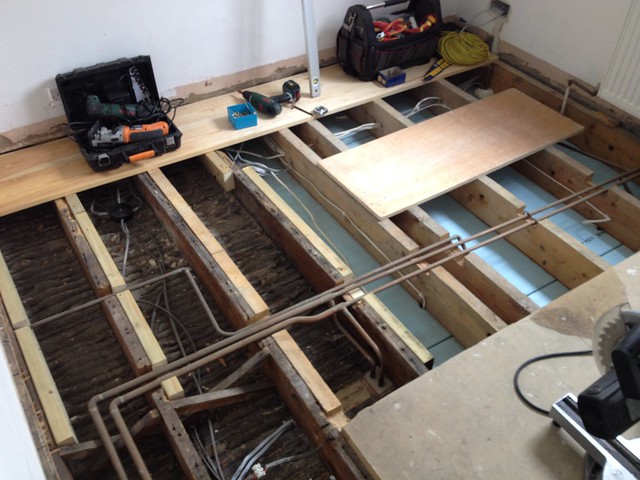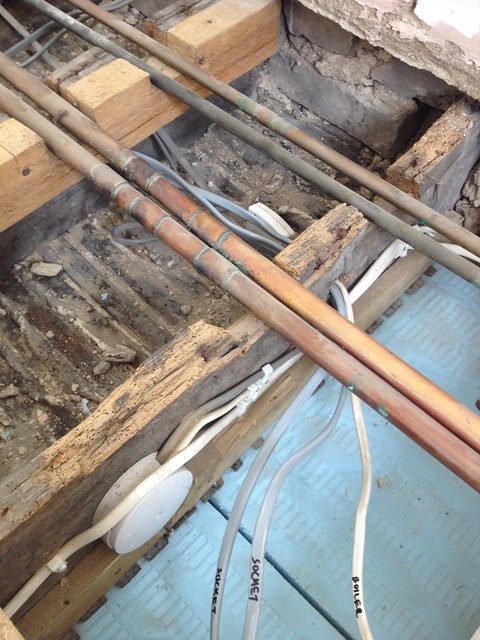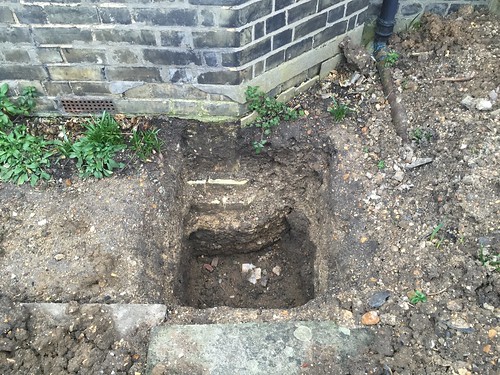- This topic has 50 replies, 30 voices, and was last updated 9 years ago by br.
-
How are Victorian London houses built?
-
Kryton57Full MemberPosted 9 years ago
I live in a 1896 semi at the end of a row of terraces, and I’m interested in knowing how the frame work of the house is, the materials, how the floor/supports/joists are etc.
And secondly do they differ from modern builds and how?
chewkwFree MemberPosted 9 years agoThere are probably ghosts in the house so have you felt something yet? 😆
Sorry no help.
Back to Black Mirror.
projectFree MemberPosted 9 years agoSuspended floor as opposed to Concrete pad,
Floor boards as opposed to osb or chipboard,
sometimes no wall in attic betweeen properties to save bricks, akllso a high theft risk by burglars going house to house through attics.
Lath and plaster ceilings and walls internally,
sliding sash windows,
creameggFree MemberPosted 9 years agoYou want to get yourself a copy of mckays building construction book.
footflapsFull MemberPosted 9 years agoAbout 6 inches of rubbles tossed on top of the soil for foundations, then a mix of single / double thickness brick walls (4.5″ or 9″ thick). The Victorian bricks are pretty dense, way more so than a modern house brick.
I love the design of them though, really nice character to them.
Kryton57Full MemberPosted 9 years agoI forgot to ask – laymans terms please…
What goes across the house to support upstairs walls etc? Wooden beams or steel?
thekingisdeadFree MemberPosted 9 years agoShonkily if my victorian terrace is anything to go by. Have just spent the last hour ‘sealing’ the gap between floor boards & skirting board with loft roll insulation. The gap was to big for frame sealant.
Cant beat the ‘character’ of old houses eh?
😉
footflapsFull MemberPosted 9 years agoProbably has 9″ solid brick walls without any sort of cavity
The walls between houses are normally 9″ (two brick widths), the front and back walls are normally 4.5″ (single brick). Then plastered with about 1.5″ of lime render. They also used lime mortar which never really sets and is able to move with the bricks as they settle.
Cant beat the ‘character’ of old houses eh?
Nope! I doubt many modern homes will be in as good nick in 100+ years time…..
jota180Free MemberPosted 9 years agoThe walls between houses are normally 9″ (two brick widths), the front and back walls are normally 4.5″
Ours (1891) is 9″ walls all round
footflapsFull MemberPosted 9 years agoI’m interested in knowing how the frame work of the house is, the materials, how the floor/supports/joists are etc.
Have a look, I had to repair / reinforce all the joists as woodworm has eaten the top 1cm away! You can see the lathes of the original ceiling. The blue stuff is an extension.
[url=https://flic.kr/p/oKbtQh]More joist repairs[/url] by brf, on Flickr
Check out that woodworm:
[url=https://flic.kr/p/oGjCoA]Wood worm damaged joists[/url] by brf, on Flickr
projectFree MemberPosted 9 years agoWhat goes across the house to support upstairs walls etc? Wooden beams or steel?
as the pics above show wooden beams set into slots in the wall floorboards are then placed over the beams in the opposite direction and the walls up stairs are then built.
Just ripped up the floor of a terraced house, huge nails rusted into beams, floor boards like new underneath, and not tounge and grooved eg not fitted into each other just touching each other and nailed down.
Some of the old houses still have hidden lead water pipes, with the pipe coming from the rear or front of the property.Look for a stop tap cover outside property.
Gas meter usually fitted internally either above front door, or in hall or in front room, nearest place to main supply from street to avoid pipe being bypassed.Same with electric meter.
Kryton57Full MemberPosted 9 years agoInteresting, thanks footflaps. So the beams are set into the wall, and the lathes – slats? – how are they fixed?
My wife just said with a worryied tone – so everything just sits on top of everything else? Why doesn’t it move side ways?
greenbailiwickFree MemberPosted 9 years agoSome are shoddily built others more robustly. I lived in a 5 storey semi detached townhouse for a few years and it was solid. There were shallow foundations because the walls started really thick in the basement then tapered to a quite thin wall in the attic. Prefer modern reinforced concrete slabs for floors myself-much more privacy and peace and quiet.
Definitely not true that “they don’t build em like they used to though”, a mate of mine renovated a Victorian terraced house and some of the original building work was a right ol bodge!
ourmaninthenorthFull MemberPosted 9 years agoLaths were nailed onto ceiling joists. Then plastered over (ceiling gets strength from lime and hair(!) plaster pushing through laths).
English bricks are 9 inches long by 4.5 inches high and deep. Laid sideways, walls are built one or two bricks deep. A solid wall means there is no gap between the two thicknesses of bricks. If you look at your outside walls you can look at the courses (rows) of bricks laid lengthways. Every few courses you’ll see a course of bricks with their ends facing out. These are used to “tie” the lengthways courses together – it gives the wall its strength.
To be honest they’re an excellent way of constructing housing, but they’re also a major part of the British Disease.
midlifecrashesFull MemberPosted 9 years agoThis is a good book.
Although lots of it is a straight lift from the old Reader’s Digest DIY manual which is in every charity shop and boot sale.
thekingisdeadFree MemberPosted 9 years agoI doubt many modern homes will be in as good nick in 100+ years time…..
Agreed!
Kryton57Full MemberPosted 9 years agoI’d like to see that brickwork OMITN. My house is rendered though.
iffoverloadFree MemberPosted 9 years agoyou may find that there is a structural wall between the front and back of the house, the ground floor may be brick,then 5×2 in then 4×2 on the top floor, the joists will be less deep as well at the top of the building,
end of terrace may/should have the exposed wall tied into the rest of the structure to stop it bowing out as well.
no real DPC in the walls either, sometimes slate was used
wrightysonFree MemberPosted 9 years agoVery few, if any for that matter external walls are single skin.
Current Victorian school I’m renovating must have been a feat of modern design when it was built. 9 inch solid then a 30/50 mm cavity with some proper old school cavity ties. We’ve tried to replicate some of the bed joints whilst repairing the facing work and have decided it must have been witchcraft that was used back then to build it!
Biggest difference nowadays is how everything had been improved in an engineering manor.
Foundations right through to roof trusses.huwsFree MemberPosted 9 years agoMy house is rendered though.
Rendered with lime or modern sand and cement? I’m at the beginnings the process of getting the sand and cement render removed from mine (London, 1865, solid walled end of terrace) to let it breath and hopefully fix some damp issues. It’s not going to be cheap.
iffoverloadFree MemberPosted 9 years agoThe bowing of gable end walls can occur for various reasons, but the lime mortar and shallow footings combined with the clay soil and heavy trafic etc are contributors in London
on some end of terrace houses you may see the decorative patress plates in position.
molgripsFree MemberPosted 9 years agoNope! I doubt many modern homes will be in as good nick in 100+ years time…..
Don’t be too sure. Just because something is old doesn’t mean it’s well made. Dodgy builders are NOT a modern invention, but building regs and trading standards are 🙂
Kryton57Full MemberPosted 9 years agoAny comment on the foundations / below ground level layout? As well as being generally interested, we feel we can smell cigarette smoke from next door, so I’m wondering if the vents and under floor space is shared with our neighbour and therefore is the channel this.
Another question – in the loft the joists seem to be self supporting, e.g the diagonals are just “propped” onto the horizontal beams, albeit they have a vertical cut out to hold the load. Is this normal, and how then is the roof fixed to the rest of the house without nuts/bolts/screws etc?
IAFull MemberPosted 9 years agoThe beams in the loft are probably nailed together. There’s also literally tons of roofing tiles/slate on top of it which will help hold it down…
Haynes do a “victorian house” manual, check your local library for a copy…
footflapsFull MemberPosted 9 years agoAny comment on the foundations / below ground level layout?
What foundations? My 1890s house is built on 6″ of rubble tossed on top of the soil!
wrightysonFree MemberPosted 9 years agoFoundations vary. Most will be off the ground below and no concrete as such. Do you have a basement? If not then there will usually be something called a spread which is wider brickwork to start with off the bearing ground. This is reduced to the final width of the wall as it comes “out of the ground”.
The horizontals are called purlins these will be supported from purlins walls below. Your diagonals or rafters sit on these to ease the load over the entire legnth from eaves to ridge. Back then it was all usually nailed together with big **** off nails!iffoverloadFree MemberPosted 9 years agothe party wall is unlikely to have any vents in it.
The chimney stack could be a source of the smell, the fireplace is often closed up and a vent may have been fitted.
footflapsFull MemberPosted 9 years agoThe chimney stack could be a source of the smell, the fireplace is often closed up and a vent may have been fitted.
Quite common for holes to appear in the chimneys as the mortar is very soft and moves as the house / roof moves. Our chimneys are no longer air tight, I could smell smoke upstairs when I lit the fire downstairs – leaking between the 4 chimneys in the stack…
ti_pin_manFree MemberPosted 9 years agoQuite common for holes to appear in the chimneys as the mortar is very soft and moves as the house / roof moves. Our chimneys are no longer air tight, I could smell smoke upstairs when I lit the fire downstairs – leaking between the 4 chimneys in the stack…
When we had a wood burner fitted we ended up needing the a concrete flue lining with concrete to seal and stabilise the chimney brick work.
mrmonkfingerFree MemberPosted 9 years agoAlso worth a read, haynes victorian house manual
Any comment on the foundations / below ground level layout?
Foundations are notable by their almost complete absence in our house. The ground floor was just dirt. It’s been covered, piecemeal, with about 2″ of screed, bit by bit. We only recently completed the screed when we changed the rotten stairs – the stringers were resting on clay tiles which were just dropped on the dirt (which was a lovely way for moisture to find its way into the stair cavity and cause it all to go rotten).
It’s pre-Victorian, but not by much (1812).
Some other stuff:
Slightly unusually, we have cavity external walls. Wall ties are bust though, and we’ve got pattress plates holding the front wall together. Although that might also be down to the base of the front wall being a few inches closer to the back wall these days, compared to when it was built, so it isn’t vertical.
First floor joists are ok – for now – and will outlast our stay in the place, but they’re sat mortared into cavities in the wall, so when they go it will be an interesting repair job.
The roof was built using any old crap the carpenter had lying around. Rafters are obviously strong enough to hold the tiles up – but the joists had to be reinforced where the cisterns are sat. It’s not a loft that was ever designed to hold anything much or be used in any way.
Straight lines were optional.
mrmonkfingerFree MemberPosted 9 years agoleaking between the 4 chimneys in the stack
Fairly common for the feathering to be shot. Doesn’t necessarily come from movement but acrid smoke and tars will eat the mortar.
Time for a liner.
Kryton57Full MemberPosted 9 years agoThe chimney stack could be a source of the smell, the fireplace is often closed up and a vent may have been fitted.
Hmm.
The shared chimney does have a vent in it which is in my daughters room, as the stack now stops there and does not continue downstairs.
Her room seems unaffected (as does upstairs in general TBH). We have a draught that comes through the floorboards via a gap around a pipe to the Gas meter in the understairs cupboard. My thoughts are that this is where the cigarette smoke filters in, as this draught does blow from rear-front of our house from under the cupboard door and the front is where our living room is off the hallway – where we smell it most. My thought was to block the gaps with a rag temporarily to see if this has an affect. However, we also have a floor vent next to our now Gas albeit original fireplace in the living room.
ransosFree MemberPosted 9 years agoUsually solid wall too so pretty cold.
Mine’s solid wall and they’re not too bad – mid terraces only have two external walls and semis usually have the hall and stairs against the main outside wall, with the living rooms against the internal wall.
My view is the badly-built Victorian stuff has already fallen down.
footflapsFull MemberPosted 9 years agoA neighbour is having some work done and they’ve dug an inspection pit to examine the footings.
No concrete foundations, just brickwork going down a few courses below ground and spreading out a bit. Would be condemned as unsafe if you built like that now!
[url=https://flic.kr/p/qFu617]Victorian foundations[/url] by brf, on Flickr
jefflFull MemberPosted 9 years agoBeen there a 100 and a bit years so looks suitable to me. Well that’s what I always say when someone mentions something like that about my house 🙂
CountZeroFull MemberPosted 9 years agoBe thankful it’s not an 18th C Cotswold farmhouse, like a friend of mine owns, plenty of ‘interesting’ building practices back then.
rureadybootsFree MemberPosted 9 years agoAs a tradesman who specializes in the restoration of period properties but has also worked on new builds I can safely say the quality of Victorian and Edwardian buildings far exceeds that of anything modern.
The topic ‘How are Victorian London houses built?’ is closed to new replies.




